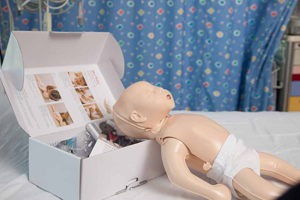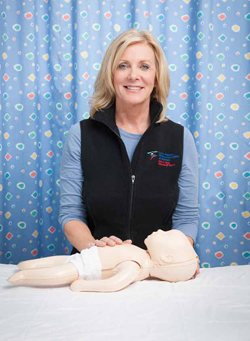January 14, 2013 - By Erin Digitale

The CPR kit tested in the study includes an instructional video and a mannequin for practicing cardiopulmonary resuscitation techniques, and is endorsed by the American Heart Association.
Many children with chronic disease or serious health conditions are at risk of cardiac arrest. Teaching their parents to perform cardiopulmonary resuscitation can save kids' lives and prevent brain damage caused by delayed resuscitation. But ensuring that these parents receive timely, effective CPR training before they leave the hospital with their child has been challenging.
Now, new research from Lucile Packard Children's Hospital shows that a video-based, self-instructional take-home CPR kit provides these families with effective, efficient CPR training. The kit tested, called CPR Anytime™, includes an instructional video and a mannequin for practicing CPR techniques, and is endorsed by the American Heart Association. Parents reported that this method of providing CPR improved their lasting knowledge of CPR techniques and improved their confidence in their ability to perform CPR, the study found. The kits also decreased the time nurses spent teaching CPR at hospital discharge, making discharge procedures more efficient. And for a few families in the study, the information parents learned may have saved their children's lives.
The findings were published Jan. 8 in the Journal for Healthcare Quality.
"Parents felt empowered," said senior author Lynda Knight, RN. "It allowed them to feel relieved that they would know what to do if something ever happened and their child required CPR after they left the hospital." Knight is the resuscitation educator for Packard Children's Center for Nursing Excellence and the director of the hospital's AHA training center.
If a child's breathing stops and his or her heart rate drops, prompt CPR can improve survival and prevent neurologic problems caused by oxygen deprivation, Knight said. But it usually takes 7 to 10 minutes for paramedics to arrive after a 911 call, a dangerously long time for the brain to go without oxygen, so it's important for parents to initiate CPR prior to paramedics' arrival.

Lynda Knight is senior author of the CPR-kit study published in Journal for Healthcare Quality.
The study examined 117 families whose children under age 18 were discharged from Packard Children's after receiving care for serious medical conditions, including premature birth; episodes of interrupted breathing or unstable heartbeat during the newborn period; solid-organ transplant; and several types of heart problems. Parents of patients who went home from the hospital using oxygen, a ventilator or a tracheostomy tube to help them breathe were also included in the study.
During their hospital stay, each family received a CPR Anytime kit and used the video and mannequin to learn basic CPR skills. The kit follows principles shown to be effective for adult learning, allowing simultaneous CPR instruction and hands-on practice.
When these young patients left the hospital, the families took the kits and were encouraged to review them again at home. The research team called the parents at one, three and six months after discharge for brief telephone surveys about their use of the kits.
Six months after hospital discharge, the majority of parents in the study felt confident in their CPR skills. Eighty-two percent of parents had watched the video at least once after leaving the hospital, and 79 percent had shared the kit with at least two other family members or friends, suggesting that the kits were also helping spread CPR skills in the community.
The fact that families could review the material at home is especially useful in light of the many other skills they had to learn in the hospital, Knight said. Children with serious medical conditions may leave the hospital with complex medication regimens or medical equipment that parents must learn to manage. Nurses, who were also questioned in the study, liked that the CPR kits reduced the amount of material they had to teach families, and appreciated that the information was consistent and that the kits prevented families from having to wait for a nurse to become available for CPR instruction before hospital discharge.
The kits may even have saved the lives of a few children in the study. Five parents who received the kits reported performing CPR on their children at home, and four of the five children survived without neurologic damage. In contrast, overall survival rates for people who receive CPR in non-hospital settings tend to be quite low; one estimate put the survival rate at 5 to 10 percent. The five parents who performed CPR said that if they had not received the kits they would not have had time to attend CPR classes. They attributed knowing what to do in this scary situation to reviewing the materials in the kit.
Knight's collaborators at Packard Children's were Alan Schroeder, MD, a former fellow in the pediatric intensive care unit; nurse educator Stephanie Wintch, RN; respiratory care practitioner Vickie Arnolde, RCP; and Amy Nichols, RN, EdD, director of the Center for Nursing Excellence at Packard Children's.
The research was funded by an Innovations in Patient Care grant from Packard Children's.
About Stanford Medicine
Stanford Medicine is an integrated academic health system comprising the Stanford School of Medicine and adult and pediatric health care delivery systems. Together, they harness the full potential of biomedicine through collaborative research, education and clinical care for patients. For more information, please visit med.stanford.edu.